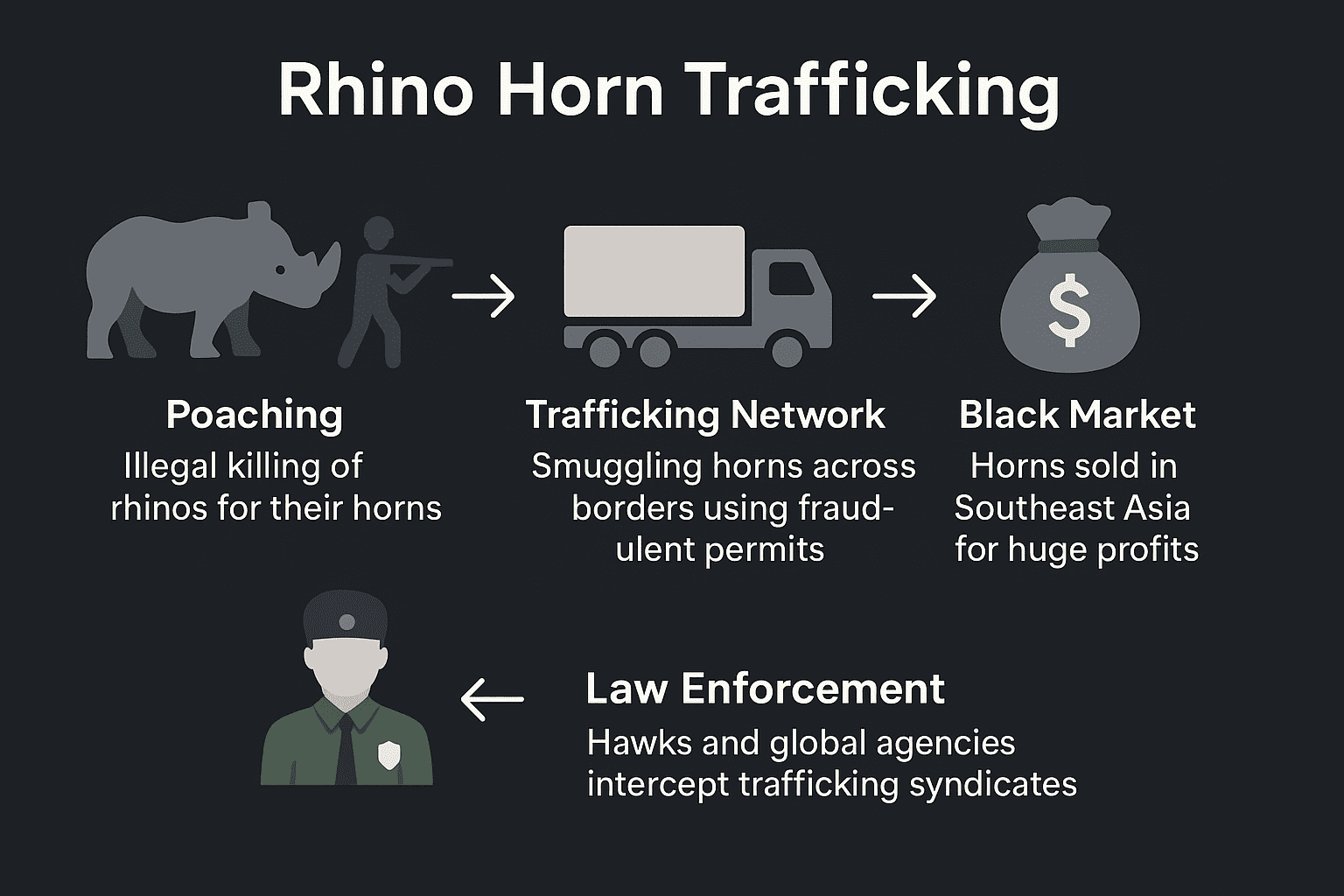Rhino Horn Trafficking: Unmasking the Hidden Global Trade
Rhino horn trafficking remains one of the most pressing environmental crimes threatening biodiversity and rule of law worldwide. While conservation efforts have made progress, criminal networks continue to exploit loopholes in national systems, funneling illegally obtained horns into lucrative international markets. This article explores the mechanisms behind these syndicates, their impact on ecosystems, and the growing determination of law enforcement to dismantle them.
1. The Rise of Rhino Horn Trafficking
Over the past two decades, rhino horn trafficking has grown into a multi-million-dollar black market industry. Driven largely by demand in Southeast Asia, where rhino horn is falsely marketed as a status symbol or traditional medicine, syndicates have capitalized on scarcity and high profit margins. This has placed African rhino populations under enormous pressure, with poaching levels soaring despite international bans on commercial trade.
2. How Criminal Syndicates Operate
Rhino horn trafficking networks operate like sophisticated corporations. They forge permits, exploit legal loopholes, and build transnational supply chains that stretch across continents. From bribing local officials to laundering money through shell companies, these groups rely on corruption and weak enforcement to sustain their operations. Such tactics make them resilient and difficult to dismantle.
3. The Role of Fraudulent Permits
One of the most common strategies used by traffickers is the acquisition of fraudulent permits. These documents allow horns to be moved legally within domestic borders but are often manipulated to mask their final destination: international markets. Investigations have revealed how this fraudulent system enables syndicates to bypass regulatory frameworks and push hundreds of horns into global demand hubs. This fraudulent documentation represents one of the biggest challenges for conservation authorities worldwide.
4. Economic Drivers Behind the Trade
The financial incentives behind rhino horn trafficking are staggering. A single horn can fetch hundreds of thousands of dollars on the black market, making it more valuable than gold or platinum by weight. This enormous profit potential attracts organized crime groups that see wildlife trafficking as low-risk compared to drug or arms smuggling. As a result, rhino horn has become a commodity traded alongside other illicit goods in underground markets.
5. The Human Cost of Trafficking
Rhino horn trafficking is not only an environmental crime but also a human tragedy. Poaching often involves armed groups who bring violence to rural communities, threatening rangers and local populations alike. Corruption further undermines governance, leaving frontline defenders underpaid and underprotected. The ripple effect extends to entire regions, destabilizing livelihoods and eroding trust in public institutions.
6. International Law and Its Limitations
The Convention on International Trade in Endangered Species of Wild Fauna and Flora (CITES) bans international trade in rhino horn. However, the existence of legal domestic markets creates loopholes that traffickers exploit. Countries with weaker enforcement mechanisms often become transit points, allowing horns to slip into global supply chains. Without stronger cross-border collaboration and harmonized laws, syndicates will continue to exploit these inconsistencies to their advantage.
7. The Role of Law Enforcement Agencies
Specialized units such as South Africa’s Directorate for Priority Crime Investigation, better known as the Hawks, play a critical role in dismantling rhino horn trafficking syndicates. Their work involves years of intelligence gathering, undercover operations, and collaboration with prosecutors. Success in these operations sends a clear message: wildlife crime is being treated as seriously as other forms of organized crime.
8. Collaboration with Conservation Groups
Law enforcement alone cannot solve the crisis of rhino horn trafficking. Conservation organizations, local communities, and international NGOs provide essential support through awareness campaigns, monitoring technologies, and habitat protection programs. Partnerships between governments and conservation groups amplify impact, ensuring that anti-trafficking strategies are both scientifically informed and socially inclusive.
9. Technological Tools in the Fight
Cutting-edge technology is increasingly being deployed to combat rhino horn trafficking. From DNA analysis that traces the origin of seized horns to drones that monitor protected reserves, innovation has become a powerful ally for conservationists. Blockchain solutions are also being explored to create tamper-proof permitting systems, making it harder for syndicates to exploit regulatory loopholes. These advancements mark a shift toward proactive rather than reactive enforcement.
10. A Path Forward: Breaking the Chains of Trafficking
Ending rhino horn trafficking requires a multi-layered strategy that combines strict law enforcement, international cooperation, community empowerment, and global awareness. Governments must continue to close legal loopholes, while communities benefit from conservation-driven economies. Education campaigns that debunk myths about rhino horn use are equally vital, reducing demand in consumer countries. Together, these measures can dismantle the networks that profit from destroying our natural heritage.
Conclusion
Rhino horn trafficking is more than a conservation issue; it is a global crime that undermines ecosystems, economies, and the rule of law. Yet, progress is being made. With the combined efforts of law enforcement agencies, conservationists, and the international community, syndicates are being exposed and dismantled. For readers seeking deeper insights into how organized crime fuels environmental destruction, resources like UNODC on Wildlife Crime provide valuable context. For additional strategies on protecting endangered species within Africa, see our related article on Endangered Species Protection. Together, these efforts remind us that safeguarding rhinos is not only about saving a species but about preserving the balance of life.




